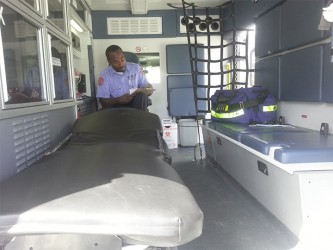Just a month after the Georgetown Public Hospital’s Emergency Medical Service began operations, Emergency Medical Technician (EMT) Ron Morris found himself delivering a baby en route to the hospital.

Morris, the EMT on duty, said that the service received a call about a pregnant woman experiencing severe abdominal pain. The ambulance picked Wendy Gill up from the road where she stood waiting for it and Morris realised that the baby’s head was already protruding. Left with no other option, Morris delivered the baby in the ambulance, and both mother and her healthy baby boy were transferred to the Maternity Ward upon arrival at the hospital. Morris related that this was just one of the numerous instances whereby the service was able to help individuals.
The service, which aims to ensure safe transport for ailing individuals, with the help of EMTs, started operations in March of this year.
This is according to Zulfikar Bux, Head of Department for Accident & Emergency at hospital, and who is responsible for the pilot programme, which is being undertaken by the hospital in collaboration with the Ministry of Health and Vanderbilt Medical Center in Nashville, Tennessee.
Prior to the programme, Guyana did not have a medical response system, and the city hospital’s ambulances were used primarily to transport hospital patients from one medical facility to another. According to Bux, this was detrimental because patients, especially accident victims, bore the brunt of this inefficiency and they may have been paralysed simply because they were not handled properly, or put in a brace. He said, “Getting a sick patient to an appropriate medical place, in a safe and timely manner is the goal of the emergency response.”
The EMTs, who would have graduated in January, are trained in the basic skills necessary. Bux explained, “There exists three levels of EMTs; basic, intermediary and full-fledged paramedics. What we’re doing, is starting small, with EMT basics. The plan was, to get a group of EMTs, train them so that they could respond.” Even though 20 students were trained, he indicated that some of the EMTs were allocated to different government agencies, such as the army.
The hospital currently has an ambulance working 24 hrs, staffed with two EMTs. Even though there are some technical difficulties with the telephone line, the emergency service can be reached on 913. Bux said, “The trained EMTs responding to this call will rush to the scene, stabilise the individual and ensure safe transport.” He, however, noted that “The EMTs at this time will not be administering medication based on their skill level.” There are, however, advances in this area; the EMTs will now contact the hospital via radio so that the doctors on call are made aware of the condition of the incoming patients, and consequently be prepared for treatment upon arrival. Bux said that the ambulance is immediately sent to locations so long as it is available but noted that the individuals answering the calls are trained professionals who dispatch the ambulance depending on the emergency. He indicated that because the programme is still quite new, there has not been an instance where the dispatchers have had to choose between two locations but he acknowledged that this is a problem that they are anticipating.
According to Bux, “The whole idea is to gradually train new EMT’s and expand in time, to implement phase 1 in Georgetown, then phase 2 hopefully in West Demerara, Berbice, and East Bank as these are the mostly populated areas. Once we cover the land transport, we will actually look at air medivacs.”
“The public needs to understand, that because it is such a small brigade we will be overwhelmed. This is just a start up, we’re not going to be perfect right now,” he said, while adding that with continued progress, these problems will be “ironed out.”
He indicated that there is currently a tentative plan to train an additional batch of EMTs in October to facilitate the additional of two more ambulances to the service. This training will be done under the supervision of Morris, who is the training and development officer. Morris, who was previously a registered nurse, was among the beneficiaries of the initial training programme.








